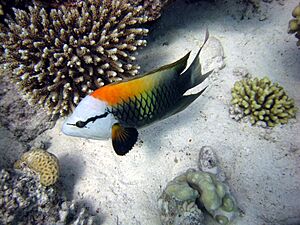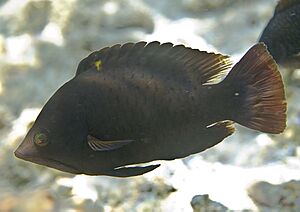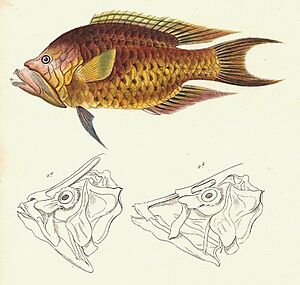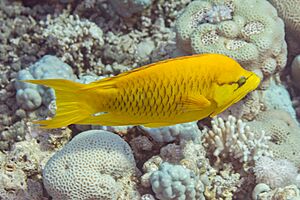Sling-jaw wrasse facts for kids
Quick facts for kids Sling-jaw wrasse |
|
|---|---|
 |
|
| male | |
 |
|
| dark female | |
| Conservation status | |
| Scientific classification | |
| Synonyms | |
|
The slingjaw wrasse (Epibulus insidiator) is a cool fish found in warm ocean waters. It lives around coral reefs in the Indo-Pacific region. This fish is special because of its amazing mouth. It can shoot its jaws forward very far! People sometimes catch these fish for food or for aquariums.
Contents
What's in a Name?
The slingjaw wrasse got its scientific name, insidiator, because it means "ambusher" or "lurker." Early scientists thought this fish might spit water to catch insects on land. This is how it got its sneaky name!
Amazing Features of the Slingjaw Wrasse
The most amazing thing about the slingjaw wrasse is its mouth. Its jaws can unfold into a long tube, almost half the length of its head! This helps it catch food.
How to Spot a Slingjaw Wrasse
Male slingjaw wrasses are usually grayish-brown. They have orange on their backs and a yellow stripe on their sides. Their heads are pale gray with a thin black line through the eye. Female slingjaw wrasses can be bright yellow or dark brown. Young slingjaw wrasses are brown with thin white stripes and white lines around their eyes. Some fish have a mix of these colors.
The slingjaw wrasse has fins with special rays. Its top fin (dorsal fin) has 9 to 10 spines and 9 to 11 soft rays. The fin on its belly (anal fin) has 3 spines and 8 to 9 soft rays. These fish can grow up to about 54 centimeters (21 inches) long.
The Super Stretchy Jaw
The slingjaw wrasse has the most extreme jaw protrusion of any fish! It can extend its jaws up to 65% of its head length. This super-fast and long jaw movement helps it grab small fish and crustaceans (like crabs or shrimp). This amazing ability comes from special ligaments and bones in its head.
Where Do Slingjaw Wrasses Live?
You can find the slingjaw wrasse across a huge area. They live from the eastern coast of Africa, including the Red Sea, all the way to the Pacific Ocean. They are found as far north as Japan and as far south as New Caledonia. They also live along the northern coasts of Australia.
Life in the Reef
Slingjaw wrasses live in areas with lots of coral. They prefer lagoons and outer reefs, often near reef slopes or drop-offs. They eat small crustaceans that live in the coral and other small fish.
Reproduction and Family Life
It's believed that slingjaw wrasses are protogynous hermaphrodites. This means they start as females and can later change into males. When males are ready to find a mate, their colors become much brighter. They swim in a special way, holding their tail fin up and their anal fin down. If they feel in danger, their colors return to normal.
Male slingjaw wrasses have a territory of about 500 to 1,000 square meters (5,380 to 10,760 square feet). Several females might live within his territory. They usually lay their eggs around high tide. The fish swim up about 2 to 3 meters (6.5 to 10 feet) into the water to spawn. Spawning has been seen in many months, including March, April, May, July, September, and October.
Clever Camouflage
The slingjaw wrasse is very smart! When a group of Indian sailfin tangs (another type of fish) comes into its territory, the wrasse changes its color. It starts to look just like the tangs! Then, it swims with the group, hiding among them. This helps the wrasse hunt for food without being noticed. It's very hard to tell the slingjaw wrasse apart from the plant-eating tangs when it's mimicking them.
Slingjaw Wrasse and People
People in many places catch slingjaw wrasses for food. They are also collected for the aquarium trade. In some areas, like Guam, the size of the fish caught has stayed steady over the years.




